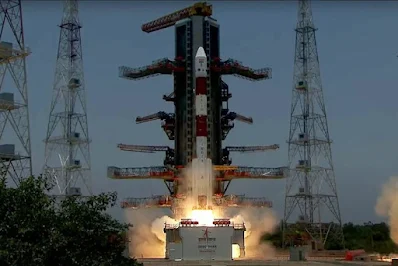India's space agency takes aim at another milestone Saturday with the launch of a probe to study the Sun, a week after its successful unmanned landing on the Moon.
Aditya-L1 will carry scientific instruments to observe the Sun's outermost layers, blasting off at 11:50 am (0620 GMT) for its four-month journey.
The United States and the European Space Agency (ESA) have sent numerous probes to the centre of the solar system, beginning with NASA's Pioneer programme in the 1960s.
But if successful, the latest mission from the Indian Space Research Organisation (ISRO) will be the first by any Asian nation to be placed in solar orbit.
"It's a challenging mission for India," astrophysicist Somak Raychaudhury told broadcaster NDTV on Friday.
Raychaudhury said the mission probe would study coronal mass ejections, a periodic phenomenon that sees huge discharges of plasma and magnetic energy
from the Sun's atmosphere.
These bursts are so powerful they can reach the Earth and potentially disrupt the operations of satellites.
Aditya will help predict the phenomenon "and alert everybody so that satellites can shut down their power", he said.
"It will also help us understand how these things happen, and in the future, we might not need a warning system out there."
Aditya -- the name of the Hindu Sun deity -- will travel 1.5 million kilometres (930,000 miles) to reach its destination.
It is travelling on the ISRO-designed, 320-tonne PSLV XL rocket that has been a mainstay of the Indian space programme, powering earlier launches to the Moon and Mars.
The mission also aims to shed light on the dynamics of several other solar phenomena by imaging and measuring particles in the Sun's upper atmosphere.
India has been steadily matching the achievements of established spacefaring powers at a fraction of their cost.
The South Asian nation has a comparatively low-budget space programme, but one that has grown considerably in size and momentum since it first sent a probe to orbit the Moon in 2008.
Experts say India can keep costs low by copying and adapting existing technology, and thanks to an abundance of highly skilled engineers who earn a fraction of their foreign counterparts' wages.
Last month's successful landing on the lunar surface -- a feat previously achieved only by Russia, the United States and China -- cost less than $75 million.
The touchdown was widely celebrated by the public, with prayer rituals to wish for the mission's success and schoolchildren following its final descent from live broadcasts in classrooms.
India became the first Asian nation to put a craft into orbit around Mars in 2014 and is slated to launch a three-day crewed mission into the Earth's orbit by next year.
It also plans a joint mission with Japan to send another probe to the Moon by 2025 and an orbital mission to Venus within the next two years.
Following the success of India’s moon landing, the country’s space agency launched a rocket on Saturday to study the sun in its first solar mission.
The rocket left a trail of smoke and fire as scientists clapped, a live broadcast on the Indian Space Research Organization’s (ISRO) website showed.
The broadcast was watched by nearly 500,000 viewers, while thousands gathered at a viewing gallery near the launch site to see the lift-off of the probe, which will aim to study solar winds, which can cause disturbance on earth commonly seen as auroras.
Named after the Hindi word for the sun, the Aditya-L1 launch follows India beating Russia late last month to become the first country to land on the south pole of the moon. While Russia had a more powerful rocket, India’s Chandrayaan-3 out-endured the Luna-25 to execute a textbook landing.
The Aditya-L1 spacecraft is designed to travel about 1.5 million km (930,000 miles) over four months to a kind of parking lot in space where objects tend to stay put because of balancing gravitational forces, reducing fuel consumption for the spacecraft.
Those positions are called Lagrange Points, named after Italian-French mathematician Joseph-Louis Lagrange.
The mission has the capacity to make a “big bang in terms of science,” said Somak Raychaudhury, who was involved in the development of some components of the observatory, adding that energy particles emitted by the sun can hit satellites that control communications on earth.
“There have been episodes when major communications have gone down because a satellite has been hit by a big corona emission. Satellites in low earth orbit are the main focus of global private players, which makes the Aditya L1 mission a very important project,” he said.
Scientists hope to learn more about the effect of solar radiation on the thousands of satellites in orbit, a number growing with the success of ventures like the Starlink communications network of Elon Musk’s SpaceX.
“The low earth orbit has been heavily polluted due to private participation, so understanding how to safeguard satellites there will have special importance in today’s space environment,” said Rama Rao Nidamanuri, head of the department of earth and space sciences at the Indian Institute of Space Science and Technology.
Longer term, data from the mission could help better understand the sun’s impact on earth’s climate patterns and the origins of solar wind, the stream of particles that flow from the sun through the solar system, ISRO scientists have said.
Pushed by Prime Minister Narendra Modi, India has privatised space launches and is looking to open the sector to foreign investment as it targets a five-fold increase in its share of the global launch market within the next decade.
As space turns into a global business, the country is also banking on the success of ISRO to showcase its prowess in the sector.


